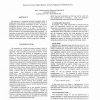Free Online Productivity Tools
i2Speak
i2Symbol
i2OCR
iTex2Img
iWeb2Print
iWeb2Shot
i2Type
iPdf2Split
iPdf2Merge
i2Bopomofo
i2Arabic
i2Style
i2Image
i2PDF
iLatex2Rtf
Sci2ools
MVA
1990
1990
Map-Driven Image Interpretation by Associative Model Indexing
d at a high abstraction level, and consists in an expectation-driven search starting from symbolic object descriptions and using a version of a distributed blackboard system for recognition [4], where a module devoted to scene analysis has been inserted. The paper is organized into in four sections. Section I1 deals with a general formulation of the problem, pointing out the characteristic of the sensors employed . Section Ill containsa brief reviewof associativememory techniques, and Section IV containsa descriptionof the model here employed and it reports preliminary results obtained on a set of real imagesand on the relatedterritorialmap. terrain map are transformed so that they can be fused with data acquired with a TV-camera, . Then, the recognition processperformedat the symbolic level is described. 21cartographivirtualsensor A topologic map (TM) representing a scenario through which an autonomous vehicle can ride provides useful informationto be used by a multisensorrecognitions...
| Added | 07 Nov 2010 |
| Updated | 07 Nov 2010 |
| Type | Conference |
| Year | 1990 |
| Where | MVA |
| Authors | Gian Luca Foresti, Vittorio Murino, Carlo S. Regazzoni, Rodolfo Zunino |
Comments (0)

